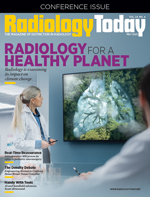 Editor’s Note: Global Guidelines
Editor’s Note: Global Guidelines
By David Yeager
Radiology Today
Vol. 24 No. 4 P. 4
We often hear about guidelines for specific radiology modalities and exams, but what about overarching guidelines for all of radiology? As the world confronts rising temperatures and climate change, that’s a question more people are asking. Radiology has been at the forefront of workflow improvements and technical innovation, so why not channel that energy into problems that affect everyone?
In this month’s cover feature, Beth W. Orenstein talks with some experts who are thinking about radiology’s role in protecting the planet. As Orenstein notes, health care contributes 8.5% of the United States’ greenhouse gas emissions each year. Because radiology interacts with nearly every department in the health care enterprise, it is in a unique position to influence health care providers’ attitudes and policies regarding sustainability. To highlight this growing concern, a recent article in Radiology discusses the challenges of sustainability and what radiologists can do to reduce their carbon footprint. Among the experts who Orenstein interviews for Radiology Today’s article is Kate Hanneman, MD, the lead author of the Radiology article.
In other news, Claudia Stahl takes a look at intraoperative MRI (iMRI) for pediatric surgery. Although not new, iMRI is growing in popularity, especially for pediatric cases; Children’s Minnesota, one of the hospitals featured in the article, recently opened an iMRI neurosurgery suite. One of the benefits, Stahl reports, is the ability of surgeons to offer more clarity to patients and their parents when discussing surgery results. Although iMRI requires additional time to perform, the potential time saved by avoiding additional surgeries makes it well worth the effort.
Speaking of guidelines, Rebecca Montz investigates the current state of breast density policy. On March 9, the FDA mandated that all nationwide mammography facilities notify patients about their breast density and how it can influence the accuracy of mammography. Even with the additional guidance, there are still debates about how early and/or often women with dense breasts should be screened, and whether they can benefit from adjunct screening methods. This state of affairs may have contributed to the ACR’s decision to issue new screening guidelines on May 3. Among the recommendations: Women should be assessed at age 25 to determine whether they would benefit from screening before age 40, and women diagnosed with breast cancer prior to age 50 or with personal history of breast cancer and dense breasts should have annual supplemental breast MRI. On May 9, the United States Preventive Services Task Force lowered its age for recommended biennial screening from 50 to 40 for normal-risk women. The USPSTF says there is insufficient evidence to determine the balance of benefits and harms of supplemental breast ultrasound or MRI for women with dense breasts who have a negative mammogram. With the added attention that is being paid to this topic, it seems likely that there will be more guidance down the road.
Finally, Keith Loria has a round-up of the latest and greatest ultrasound advances. Handheld applications are gaining ground and, as with many other aspects of radiology (and the world), AI is playing a larger role. Turn to page 22 for the details.
Enjoy the issue.
— Dave Yeager
david.yeager@gvpub.com
